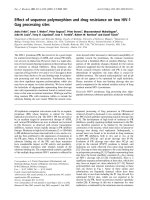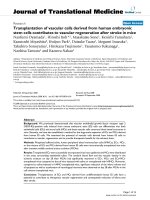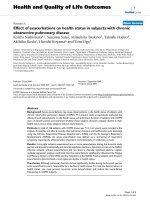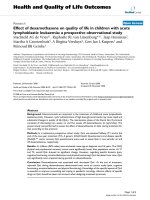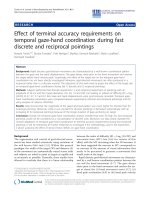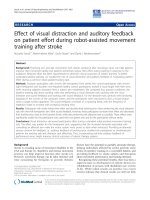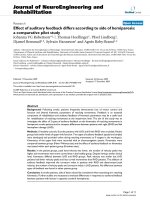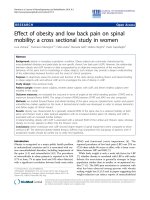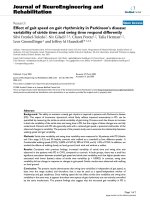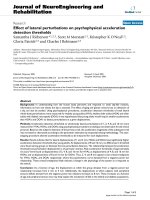Báo cáo hóa học: " Effect of visual distraction and auditory feedback on patient effort during robot-assisted movement training after stroke" ppt
Bạn đang xem bản rút gọn của tài liệu. Xem và tải ngay bản đầy đủ của tài liệu tại đây (997.96 KB, 10 trang )
RESEARCH Open Access
Effect of visual distraction and auditory feedback
on patient effort during robot-assisted movement
training after stroke
Riccardo Secoli
2*
, Marie-Helene Milot
2
, Giulio Rosati
1
and David J Reinkensmeyer
3
Abstract
Background: Practicing arm and gait movements with robotic assistance after neurologic injury can help patients
improve their movement abili ty, but patients sometimes reduce their effort during training in response to the
assistance. Reduced effort has been hypothesized to diminish clinical outcomes of robotic training. To better
understand patient slacking, we studied the role of visual distraction and auditory feedback in modulating patient
effort during a common robot-assisted tracking task.
Methods: Fourteen participants with chronic left hemiparesis from stroke, five control participants with chronic
right hemiparesis and fourteen non-impaired healthy control participants, tracked a visual target with their arms
while receiving adaptive assistance from a robotic arm exoskeleton. We compared four practice conditions: the
baseline tracking task alone; tracking while also performing a visual distracter task; tracking with the visual
distracter and sound feedback; and tracking with sound feedback. For the distracter task, symbols were randomly
displayed in the corners of the computer screen, and the participants were instructed to click a mouse button
when a target symbol appeared. The sound feedback consisted of a repeating beep, with the frequency of
repetition made to increase with increasing tracking error.
Results: Particip ants with stroke halved their e ffort and doubled t heir tracking error when performing t he visual distracter
task with their l eft he miparetic arm. With sound feedback, however, these participants increased their effort and decreased
their tracking error close to their baseline levels, while also performing the distracte r task s uccessfully. These effects were
significantly smaller for the p articipants who used their non-paretic arm and for the participants without stroke.
Conclusions: Visual distraction decreased participants effort during a standard robot-assisted movement training
task. This effect was greater for the hemiparetic arm, suggesting that the increased demands associated with
controlling an affected arm make the motor system more prone to slack when distracted. Providing an alternate
sensory channel for feedback, i.e., auditory feedback of tracking error, enabled the participants to simultaneously
perform the trac king task and distracter task effectively. Thus, incorporating real-time auditory feedback of
performance errors might improve clinical outcomes of robotic therapy systems.
Background
Stroke is a leading cause of movement disability in the
USA and Europe [1]. Repetitive and intense movement
practice can help improve function after stroke [2].
However, movement therapy can be labor intensive and
time consuming for therapists to provide. Robotic
devices have t he potential to partially automate thera py,
helping individuals affected by stroke perform some
forms of repetitive training in a controlled fashion, and
providing feedback to stroke subjets and therapists
about movement performance and training intensity.
Recognizing these potential benefits, there has been a
rapid increase in development of robotic devices for
rehabilitation of persons with disabilities (see reviews
[3-6]). While initial results are positive, two recent
reviews indicate that clinical results are still not fully
* Correspondence:
2
Biomechatronic Lab., Departments of Mechanical and Aerospace
Engineering, University of California, 4200 Engineering Gateway, Irvine, CA
92697-3875 Irvine, USA
Full list of author information is available at the end of the article
Secoli et al. Journal of NeuroEngineering and Rehabilitation 2011, 8:21
/>JNER
JOURNAL OF NEUROENGINEERING
AND REHABILITATION
© 2011 Secoli et al; licensee BioMed Central Ltd. This is an Op en Access article distributed under the terms of the Creative Commons
Attribution License (http://creativecommons .org/licenses/by/2.0), which permits unrestricted use, distribution, and reproduction in
any medium, provided the original work is properly cited.
satisfactory [7 ,8], the gain achieved u sing robot therapy
is still small and it needs to be improved.
Currently, most robotic therapy devices physically
assist th e patient in performing games presented visually
on a computer display. The rationale for physically
assisting movement is that it provides novel sensory and
soft tissue stimulation, demonstrates how better to per-
form a movement, and increases the motivation of t he
patient to engage in therapy [9]. However, an unin-
tended and possibly negative effect of providing assis-
tance is that subjects may reduce their effort and
participation in the t raining. A reduction of patient
effort in response to robotic assistance has been docu-
mented for both arm training [10] and gait training [11].
This reduction has been hypothesized to explain the
diminished b enefits of robo t-assisted gait training com-
pared to conventional gait training, although other
explanations are possible such as inapp rop ria te sensory
stimulation or lack of k inematic variability in training.
These are recently documented for chronic stroke
patients who were ambulatory at the start of robotic
training [12]. In the extreme, if a patient is passive as a
robot moves his or her limbs, the effectiveness of repeti-
tive movement training is substantially reduced [13]. But
even a moderate reduction in patient effort may dimin-
ish training effectiveness.
Developing a better understanding of the brain
mechanisms that control the slacking response is impor-
tant for optimizing robot therapy. One view of slacking
is that it is a natural consequence of the computational
mechanisms that the human motor system uses to adapt
to novel dynamic environments. Specifically, humans
adapt to robot-generated dy namic enviro nments in a
way that appears to minimize a cost function with both
error and effort terms [14]. Thus, if a robot assists in
maintaining movement accuracy, in this model the
motor system will systematically seek to reduce effort,
as has been shown experimentally [10,15-17]. However,
the instruction to the patient, psychological factors, and
visual feedback [18] may also influence slacking.
The human motor system has a limited capacity to
multi-task [20], therefore we hyphothesize t hat patients
who a re distracted by a secondary task might therefore
reduce effort for a movement task, especially if the kine-
matic effects of the effort are ameliorated by robotic
assistance. Consistent with this hypothesis, in a pilot
study with unimpaired participants [21], we found that a
relatively mild visual distr acter introduced during a typi-
cal robotic therapy tracking exercise significantly
increased the participants’ tracki ng errors as well as the
interaction forces against the robot. In the present
study, we sought to determine whether participants with
chronic stroke slacked when asked to perform a distrac-
ter task during a robot-assisted arm t racking task. We
also studied whether using a secondary feedback chan-
nel, the auditory system, to inform participants of track-
ing error could help them better perform the tracking
and distracter tasks, simultaneously, consistent with
recent research that has shown that sound feedback can
help subjects af fected by strok e improve the ir tracking
performance [22].
Methods
Subjects
Individuals with hemiparesi s were included in the study
if they had a chronic unilatera l stroke (> 6 months), and
showed some motor recovery at the affected elbow and
shoulder (score > 10/42 on the Arm Motor Fugl-Meyer
scale, excluding the hand a nd wrist components). Any
subject presenting with severe spasticity (score > 4 on
the modified Ash-worth spasticity scale), severe hemine-
glect (score ±1 on the Line Cancellation Task), ideomo-
tor apraxia (score < 3 on either hand on the modified
Alexander test ) or color blindness (unable to distinguish
red and green colors) was excluded. Informed consent
was obtained f rom each subject before the evaluation
session, and the UC Irvine Institutional Review Board
approved the study. To determine subject’s eligibility, a
study member assessed motor impairment at the
affected upper extremity by means of the Arm Motor
Fugl-Meyer Scale (excluding the wrist and hand compo-
nents; normal = 42) [23]. Spasticity at the affected upper
extremity was assessed by the modified Ashworth Spas-
ticit y Scale [24] (normal = 0). Heminegle ct and ideomo-
tor apraxia were evaluated with the Line Cancellation
Task (normal = 0 omissio ns) [25] and the ideomotor
apraxia Scale (norma l = 5) [26], respectively. Color
blindness was assessed by presenting the subjects with
two color-coded sheets (one green and one red), repre-
senting the color of the visual distracters, and asking
them to name the color of each sheet. A total of 14
individuals with left hemiparesis and 5 with right hemi-
paresis participated in the study. The mean age and
time since stroke of the 14 participants (54% female,
46%male) were 56.3 ± 12.3 years. The mean Arm Motor
Fugl-Meyer Scale was 25.9 ± 4.9, a nd the mean Ash-
worth score was 1.92 ± 0.8 and 0.86 ± 0.36 at the
affected elbow and shoulder, respectively (see Table 1).
No subject presented hemineglect (Line Cancellation
Task score: -0.003 ± 0.001), ideomotor apraxia (5 ± 0)
or color blindness. The 5 individuals with right hemi-
paresis (20% female, 80% male) w ho used their non-
paretic arm for tracking had a mean age of 61.8 ± 5.0
years. Their mean Arm Motor Fugl-Mey er Scale was
36.0 ± 2.2, and the mean Ashworth score was 0.75 ± 0.5
and 0 ± 0 at the affected elbow and shoulder, respec-
tively. We selected right hemi-paretic participants who
had enough residual hand movement ability to click the
Secoli et al. Journal of NeuroEngineering and Rehabilitation 2011, 8:21
/>Page 2 of 10
mouse without difficulty. The rehabilitation robot used
in this study was used in its left-handed configuration.
Therefore, all participants used their left hand to per-
form the tracking task, yielding 14 people with stroke
who participated with their paretic arm, and 5 with
their non-paretic arm. We also recruited 14 participants
(18% female, 82% male) with a mean age of 27 ± 7.53
years old without motor impairment, to perform the
whole experiment.
Experimental set-up
We simulated a situation that occurs frequently during
robot-assisted rehabilitation therapy in which a patient
attempts to perform a visua l movement tracking task,
but his or her attention is perturbed by distract ers
appearing in the environment. In the clinic, the distrac-
ter might be other people moving or talking in the
environment, the p atient’s own thoughts, or objects of
interest in the visual field. To create a controlled experi-
ment, we created a distracter using a secondary v isual
task on the computer screen.
We designed a tracking task, similar to commonly-used
robotic therapy tracking tasks, for which subjects had to
follow a target on a computer screen as accurately as pos-
sible in a cyclic left-to-right movement using their
affected upper extremity. Note that the movement trajec-
tory was entirely horizontal (in the X axis), and required
a left-to-right motion of about 18 inches long with a
“minimum jerk” velocity profile for the target [27]. The
subject’s hand position (midpoint of the robot ’ sstick
handled b y the subject) wa s rep resented by a green dot
and the target position was represe nted by a red dot. The
user interface was implemented using Microsoft Visual
Basic .NET and OpenGL (see Figure 1). While tracking
the target, the subjects were asked to click a mouse using
their hand not positioned in the robot when a goal visual
distracter appeared on the computer screen. The visual
distracters varied randomly according to the combination
of three parameters: color (red or green), position of the
distracter (bottom left or right of the computer screen)
and position of a yellow horizontal line (above or below
the distracter); by varying these features, eight total dis-
tracters were possible. The two goal distracters were cho-
sen f rom among the eight combinations, for which
participants were instructed to click the mouse button,
consisted of a green colored dot with a yellow line above
appearing at the bottom left of the screen, or a red d ot
with a yellow line below appearing at the bottom right of
the screen. The visual distracters we re shown for 2 sec
Table 1 Subjects with left hemiparesis
Subj. Age
(years)
Time since stroke
(months)
Gender Arm Motor FM score
(/42)
Mod. Ashworth score (/4)
Elbow Shoulder
1 71 113 F 20 2 1
263 60 F 28 3 1
377 89 F 15 2 1
4 59 148 M 20 1 1
553 18 M 23 3 0
647 36 M 25 2 1
7 48 171 F 28 1 1
872 6 F 25 1 1
962 79 F 31 2 1
10 65 101 M 31 3 0
11 37 37 F 32 1 1
12 46 15 M 27 2 1
13 43 8 M 27 1 1
14 46 30 F 30 3 1
Figure 1 Human Machine Int erface.Visualandaudiointerface
used for the tracking task: Target position is represented by a red
filled dot (black dot in the figure) and hand position is represented
by a green filled dot (light gray dot in the figure) in a black screen
(white in the figure). A visual distracter is also shown in the bottom
right corner.
Secoli et al. Journal of NeuroEngineering and Rehabilitation 2011, 8:21
/>Page 3 of 10
with a random time gap between 1 and 5 sec between
each distracter.
The robot used to assist in performing the tracking task
was a pneumatic e xoskeleton, the Pneu-WREX [28],
which has been used previously in a study of robotic
therapy with over 30 participants with chronic stroke
[29]. The Pneu-WREX (see Figure 2) evolved from a pas-
sive rehabilitation device called the T-WREX [30]. T he
Pneu-WREX is able to generate large forc es within a
gooddynamicrange(likeatherapist’s assistance) using
nonlinear control techniques [31]. The contr oller used to
assist the patient in moving during the experiments was
an adaptive controller with a forgetting term developed
previously [32]. The adaptive controller uses a measure-
ment of tracking error to b uild a model of the forc es
needed to assist the arm in moving. The model is repre-
sented as a function of the position of the arm, using
radial basis functions whose parameters are updated with
a standard adaptive control law; other ways to implement
the model have been developed [33] . Building a model of
the forces needed to move the arm allows the robot to be
made more compliant, since it no longer needs t o rely
solely on position feedback to decrease tracking error.
Essentially, the resulting controller models the forces
needed to assist the subject, as learned from tracking
errors, and reduces its effort with time on an exponential
basis when kinematic error is small.
For some exercises, we provided sound feedback of
tracking error, developed using Microsoft DirectX9. The
sound feedback was a sequence of tonal beeps, with
each beep sampled at a frequency of 800Hz and lasting
0.1sec. The f requency of repetition of the tonal beeps
varied proportionally to the vector magnitude of the
position tracking error, with a dead zone of 1in. around
the target. The beep was produc ed using either the left
or the right audio channels according to the direction of
error a nd it was provided by the speakers integrated in
the monitor.
Experimental protocol
Each subject’s left upper extremity was positioned in
Pneu-WREX and secur ed with Velcro straps (see Figure
2). Subjects were asked to complete five different track-
ing tasks, which were presented in random order for
each subject. Overall, each task was executed by each
group an equal number of times in order to avoid ran-
domization bias:
• Task A: (the “baseline” tracking task) track the tar-
get without the visual distracter and without sound
feedback
• Task B: track the target with the visual distracter
and without sound feedback
• Task C: track the target with the visual distracter
and with sound feedback
• T ask D: track the target without the visual distrac-
ter and with sound feedback
• Task E: same as task A, but with the subject
instructed to completely relax their af fected upper
extremity. This task provided a measurement of the
arm weight of the subject, as the robot control algo-
rithm adapted to lift the subject’spassivearmto
perform the tracking task, and we recorded the force
the robot generated to do this.
The normalization of the force in Z axis (F
z
)andthe
position error in Z axis (ΔZ) were calculated for each
task based of t he robot assistance force provided during
the task E. For example, the F
z
can be summarized with
the following formula:
F
zTaskk
=
120
i
=1
F
z
(
i
)
Ta sk k
F
z
(
i
)
Ta sk E
With k = A, B, C, D and i is the cycle during each
task. The position error in Z axis is based on the follow-
ing formula:
Z
Ta sk k
=
120
i
=1
Z
z
(
i
)
Ta sk k
Z
z
(
i
)
Ta sk E
Figure 2 Pneu-WREX. Pneumatic exoskeleton [28] used to perform
clinical trials.
Secoli et al. Journal of NeuroEngineering and Rehabilitation 2011, 8:21
/>Page 4 of 10
The robot assisted the subjects’ tracking movement,
just as in most forms of robotic-assisted therapy. Each
task consisted of 20 continuous repetitions of the left-
right-left movement, with each repetition last ing six sec-
onds (total duration of each task: 120s). A 10-s pause
was given to the participants between each task. During
each task, target and hand positions, velocity, robot
force and mouse button status (Tasks B and C only)
were sampled at a frequency of 200Hz and used for ana-
lysis as well as each subject’s position errors and forces
for the X (left-right) and Z (up-down) ax es. The Y axis
(front-back) was left uncontrolled with the robot in
back-drive mode in this direction.
Data Analysis
We performed a comparison between paired groups
(Shapiro-Wilk Normality Test and D’Agostino-Pearson
omnibus norma lity test) and found that the distribution
was Gaussian for data related to the force in z dimen-
sion and non-Gaussian for data related to error in z
dimension. Thus we performed a parametric t-test to
evaluate the robot assistance between the different tasks
and non-parametric t-tests (Wilcoxon t-test) to compare
the participants’ position error. For the participants with
stroke a nd healthy participants, 1 outlier was discarded
in each case because the participant misunderstood the
execution of the tasks. Also, we analyzed the distracter
task in order to understand how the participants exe-
cuted the task with/without sound feedback. The suc-
cess rate was calculated as percentage of the distracter
trials when the subject correctly clicked the mouse
within a 2.5 second window after a goal distracter
appeared.
Results
The results are presented for 13 p articipants with left
hemiparesis secondary to a stroke, 5 participants with
right hemiparesis and 13 healthy participants. For the
hemiparetic arms on the baseline tracking task, the par-
ticipants supported about 50% of their arm weight, with
the robot adapting to provide the other 50% of support
needed to lift the arm and perform the horiz ontal track-
ing t ask (Figure 3). Introduction of the visual distracter
task caused participants to reduce their effort, as evi-
denced by a significant increase in the robot assistance
force in the vertical (Z) direction (Figure 3, p = 0.001,
comparison between Task A and Task B). The amount
of increase was approximately 25% of arm weight; thus
participants with stroke who used their impaired arm
for the task reduced their force in the vertical direction
by about half when performing the visual distracter task.
The vertical position tracking error doubled (Figure 4,
p = 0.0012). There were no significant increases in
robot assistance force or position tracking error in the
left-right (X) direction.
Again for the hemiparetic arms, sound feedback of
tracking error provided during the visual distraction
task significantly decreased the assistive force provided
by the robot (Figure 3, p = 0.027) and the position error
(Figure 4, p = 0.0034, comparison between Task B and
Task C), restoring these measures close t o their value
during the default visual tracking task (Task A). The
success rate for correctly clicking the mouse button
when the distracter appeared was 65% for task B and
63% for task C.
The sound feedback also increased patient effort when
no visual distracter was p resent. When comparing the
tracking task with sound feedback (task D) to the base-
line tracking task (task A), there was a significant
Robot Force in Z Dimension
0
50
100
75
25
Task A: Baseline tracking
Task B: with Visual Distractor
Task C: with Visual Distractor
and Sound feedback
Task D: with Sound feedback
P = 0.009
P = 0.001
P = 0.027
Fz [% Arm weight]
Figure 3 Robot force in Z dimension. Robot assistance force in
the z (vertical) direction for participants with stroke using their
paretic arms to track, relative to assistance force when the
participants completely relaxed their arms in Task E.
Position Error in Z dimension
-100
-50
0
-25
-75
Task A : Baseline tracking
Task B: with Visual Distractor
Task C: with Visual Distractor
and Sound feedback
Task D: with Sound feedback
P = 0.0012
P = 0.0034
%ΔZ / ΔZe
Figure 4 Tracking error in Z dimension.Positionerrorfor
participants with stroke using their paretic arms to track, relative to
tracking error when the participants completely relaxed their arms
in Task E.
Secoli et al. Journal of NeuroEngineering and Rehabilitation 2011, 8:21
/>Page 5 of 10
decrease in the robot-assisted force (Figure 3,
p = 0.009). However, no significant difference in
position error was noted when comparing these two
tasks (p > 0.05).
We analyzed whether the decrease in effort caused by
the distracter task was related to the use of the hemi-
paretic arm for tracking, or whether a similar decrease
was seen when a control group of 13 young, non-
impaired participants and 5 participants with stroke,
using their non-p aretic arm, performed the trac king
task. The robot adapted to provide near zero assistance
when these participants used their non-paretic/non-
impaired arms for the default tr acking task (Figure 5).
Figure 6 shows that introducti on of the vi sual distracter
caused a si gnificant increase (*p = 0.004) in robot assis-
tance force for hemiparetic arm, but n ot for the non-
paretic/non-impaired arms. The size of this increase was
larger for the hemiparetic arm as compared to the non-
impaired arm of the young participants (p = 0.004), but
not as compared to the non-paretic arm of the stroke
participants (p = 0.11). The introduction of sound feed-
back had a greater differential impact on the force pro-
duced by the hemiparetic arm compared to the non-
paretic/non-impaired arm, with or without the visual
distracter (respectively: *p = 0.0085 and *p = 0.0023).
Discussion and Conclusion
We found that participants with stroke substantially
reduced their force production during a typical robot-
assisted therapy tracking task, when presented with a
secondary visual distracto r. This effect was more pro-
nounced when the arm used for tracking was hemipare-
tic. Introduction of sound feedbac k of tracking error
allowed participants to perform the distractor task while
maintaining their effort at the tracking task. We first
discuss the implications of these results for robot-
assisted therapy, and then discuss sound f eedback with
respect to robotic therapy device design.
Distraction, attention demands, and robot-assisted
therapy
An unintended consequenc e of robot-assisted therapy is
that th e patient may sometimes reduce his or her efforts
toward trying to move, as has been documen ted for arm
[10] and gait training [11]. Ironically, this reduction of
effort is facilitated at least in part by the robot itself:
robotic assistance preserves the desired kinematics of
motion, reducing the errors that might normally keep
effort level s high. Such a reduction in effort may reduce
the effectiveness of training. For example, one recent
study found that training with a gait robot without any
feedback of effort, a training approach which had pre-
viously been documented to reduce the energy con-
sumption of individuals affected by stroke during
walking [11] compared to therapist-assisted gait training,
was about half as effective as conventiona l gait training
without robotic assistance to the legs, at least for
chronic stroke subjects who were ambulatory at the
study onset. Another recent study compared passive
range of m otion exercise of the upper extremity to
EMG-triggered FES, which required effort from th e
patient, and found that the passive exercise was substan-
tially less effective [13]. Comparisons of active and pas-
sive motor learning in non- impaired subjects a re
consistent with this finding [34-37]. If patient effort is
important for promoting motor recovery, then identify-
ing the factors that reduce effort, and designing ways to
counteract these factors is important. In the present
study, we found that introduction of a simple visual dis-
tracter task substantially reduced the effort of partici-
pants with chronic stroke during a standard robot-
assisted therapy tracking task.
A similar reduction was not found for age-matched
participants with stroke who used their non-paretic arm
to reach, nor for participants without impairment. We
hypothesize, first, that stroke survivors required
increased attention to move their paretic arms; i.e. they
have reduced automaticity for arm movement. Then, the
propensity for slacking is likely tied to this increased
attention requirement. These results are consistent with
the finding that a secondary cognitive task r educes gait
speed after stroke [38], although in that study, unlike
the c urrent one, the reduction seemed more associated
0
20
40
60
80
Stroke-P Stroke-N Control
p = 0.0075 p = 0.5
Fz [% Arm weight]
Figure 5 RobotforceinZdimensionduringthebaselinetask
(Task A). (Stroke-P: stroke with paretic arm - Stroke-N: stroke with
non-paretic arm - Control: subjects without impairment). Robotic
assistance force in the z (vertical) direction for stroke participants
using their paretic arm ("Stroke-P”), stroke participants using their
nonparetic arm ("Stroke-N”), and control participants without stroke
("Control”). Task A: Baseline tracking without distractor or sound
feedback.
Secoli et al. Journal of NeuroEngineering and Rehabilitation 2011, 8:21
/>Page 6 of 10
with aging than the strok e per se. An intere sting follow-
up experiment would be to measure whether non-
impaired participants slackwhentheymakehigh-effort
movements, to determine if the increased attention
demand is related to weakness due to the stroke or the
stroke itself. Attentional demand has previously been
found to affect maximum f orce production in non-
impaired subjects [39].
Inthisstudyweexaminedhoweffortchangedwith
distraction, because we hypothesize that effort is linked
to clinical outcomes. Other studies have found that
short-term motor learning itself degrades in the pre-
sence of a distracter, with the degradation worse in the
beginning of learning or when subjects have a motor
deficit [20,36,40-44]. The present study confirms that
even a simple visual task acts as an interfering influ-
ence on movement control of ta sk after stroke, leading
us to hypothesize that short term learning also would
be affected by a visua l distracter. This research thus
suggests that it i s important to remove even simple
distractors from the training environment during
robot-assisted movement training of people with
stroke. Failure to control for distracting influences may
at a minimum increase variability of results, and at
worse diminish clinical benefi ts of robotic therapy.
Another important direction for design of robot ther-
apy is to reduce the assistance as much as possible.
For example, if users of the devices experience obvious
kinematic consequences when they are distracted, they
may be less inclined to become distracted. In the opti-
mization framework for modeling slacking we devel-
oped previously [14], the effects of a distractor as
observed here could be accounted for by a reduction
in the internal weight assigned to the effort component
of the cost to minimized. In this framework, the cost
function that the moto r system minimizes would thus
be affected by the attention demands placed on the
motor system.
-50
0
50
-30
-10
10
30
Task A - Task D: Change due to sound
feedback, with no distracter
Stroke-P Stroke-N
Stroke-N
Stroke-NControl
Control
Control
Stroke-P Stroke-P
Task C - Task B: Change due to sound
feedback in presence of distracter
Task B - Task A: Change due to distracter
Fz [% Arm weight]
P = 0.11
P = 0.093
P = 0.06
P = 0.94
P = 0.005
P = 0.093
*
*
*
P = 0.004
P = 0.0029
Figure 6 Robot force in Z dimension between the experimental group and the control group (non-impaired arm of stroke and
healthy participants). Change of robotic assistance force in the z (vertical) direction for stroke participants using their paretic arm ("Stroke-P”),
stroke participants using their non-paretic arm ("Stroke-N”), and control participants without stroke ("Control”). Task A: Baseline tracking without
distractor or sound feedback. Task B: with visual distractor. Task C: with visual distractor and sound feedback. Task D: with sound feedback and
no distractor. (* = significant difference in the change of robotic assistance compare to zero assistance: in particular Task B -Task A has p =
0.0004, the Task C -Task B has p = 0.0085 and the Task A - Task D has p = 0.0023).
Secoli et al. Journal of NeuroEngineering and Rehabilitation 2011, 8:21
/>Page 7 of 10
Sound feedback and robot-assisted therapy
Remarkably, we found that introduction of a simple
form of auditory feedback eliminated the slacking that
arose from performing the secondary distracter task.
Participants not only continued to perform the distrac-
ter task with a similar success rate, but increased their
effort back toward their baseline levels with the aid of
auditory feedback. A likely explanation is that introduc-
tion of the visual distracter task overloaded the visual-
mot or channel; provision of feedback through the audi-
tory system allowed better parallel processing. Rather
than acting as a confounding influence or another dis-
tracter, the sound feedback enhanced the visuo-motor
control because it provided similar information [45].
An important implication of this finding is that
increased attention should be paid to incorporating
effective forms of auditory feedback during robot-
assisted movement training. Our impression is that
auditory feedback is underutilized in most robotic ther-
apy systems, playing a role as background music or sig-
nifying only task completion, although there are
attempts to use auditory feedback in a more sophisti-
cated way (e.g. [22,46-48]. In one study, when people
with chronic stroke practiced reaching with sound feed-
back that informed them about the deviation of their
hand from the ideal path, they signific antly reduced
their position error after training [48]. A control group
that did the same exercise without feedback did not
improve its performance. In another study , a virtual rea-
lity training system that incorporated sound feedback of
reach position and speed helped subjects with traumatic
brain injury improve their reaching ability [49]. Another
study found that lower extremity training of individuals
with chronic hemiparesis using a robotic device coupled
with Virtual Reality (including visual and audio feed-
back) improved walking ability in the labor atory and the
community better than robot training alone [50].
These studies suggest that incorporation of augmented
feedback can improve not only performance but also
long-term motor learning after stroke. In the present
study, we only demonstrated that auditory feedback
improves short-term performance, measured by force
output and tracking error. Future studies are needed to
determine how providing auditory feedback of error can
best improve learning of arm movement after stroke.
We hypothesize that auditory feedback can serve to
keep the subjects effort level elevated, as demonstrated
here, which should improve use-dependent plasticity by
reducing passivity. However, there is a possibility that
subjects could come to rely on the auditory feedback to
drive their performance, reducing transfer to real-life
arm movements in which auditory feedback is not avail-
able. Thus, in testing the long-term effect of auditory
feedback, in ma y be importan t to fade the feedback, or
to provide it only intermittently, in order to reduce any
possible growing dependence on it. Further, challenging
the patient by intermittently providing a distracting
environment with and without the aid of auditory feed-
back to overcome that distraction may be an appropriate
way to allow people to learn to move w ell in the pre-
sence of distractors.
Another recent s tudy found that the effect of sound
feedback during reaching after chronic stroke depended
on the hemisphere that was damaged by the stroke [22].
In this study, participants heard a buzzing sound similar
to the sound of a fly, with the volume of the buzz
increasing wit h proximity to a reach target, and in some
cases, the spatial balance of stereo sound was also
altered by the orientation of the hand with respect to
the target. Such sound feedback improved abnormal
curvature in participants with right hemisphere damage
(i.e. part icipants who were left hemiparetic, like the ones
in our study), and degraded curvature, peak velocity,
and smoothness in participants with left hemisphere
damage [22]. Robertson suggested that this result might
be explained by either a difference in processing of audi-
tory information, possibly due to receptive aphasia asso-
ciated with left hemisphere damage, or to the fact that
each hemisphere has a different role in movement
control.
In the current study, we used a small sample of people
with left hemiparesis for convenience: the robot was
setup for left-handed use, and switching it was cumber-
some. This choice may have bee n fortuitous, as the
Robertson study suggests that people with left hemipar-
esis benefit more from sound feed-back. Further investi-
gation is needed to understand if the sound feedback
provided during a distraction task could be helpful also
for right-hemiparetic subjects. Another factor affecting
generalizability of the current result s is that the partici-
pants recruited presented a narrow range of impair-
ments at the affected upper extremity (Fugl-Meyer score
range 15-32). In addition, the study excluded individuals
presenting severe impairments at the affected upper
extremity, which represent up to 30% of stroke survivors
[51]. Future studies should look also at the impact of
auditory feedback on a broader spectrum of level of
impairment after stroke. Finally, upcoming research
should also examine how auditory feedback can best be
crafted to improve learning and motor recovery.
Acknowledgements
Support was provided by N01-HD-3-3352 from NIBIB and NCMRR and NIH-
R01HD062744-01f from NCMRR.
Author details
1
Robotics Lab, Department of Innovation in Mechanics and Management,
University of Padua, Via Venezia 1, 35131 Padova, Italy.
2
Biomechatronic Lab.,
Departments of Mechanical and Aerospace Engineering, University of
Secoli et al. Journal of NeuroEngineering and Rehabilitation 2011, 8:21
/>Page 8 of 10
California, 4200 Engineering Gateway, Irvine, CA 92697-3875 Irvine, USA.
3
Departments of Mechanical and Aerospace Engineering, Anatomy and
Neurobiology, and Biomedical Engineering, University of California, 4200
Engineering Gateway, Irvine, CA 92697-3875 Irvine, USA.
Authors’ contributions
RS designed and developed the multi-feedback interface, ran the study
(design of experiments and ran clinical trials), performed the statistical
analysis and drafted the manuscript. MH helped during the clinical trials,
carried out to the recruitment of subjects and assessed the medical trials.
DJR and GR contributed concepts, edited and revised the manuscript. All
authors read, edited and approved the manuscript.
Competing interests
The authors declare that they have no competing interests.
Received: 31 July 2010 Accepted: 23 April 2011 Published: 23 April 2011
References
1. Lloyd-Jones D, et al: Heart Disease and Stroke Statistics-2009 Update: A
Report From the American Heart Association Statistics Committee and
Stroke Statistics Subcommittee. Circulation 2009, 119:21-181.
2. Nudo RJ: Post-infarct cortical plasticity and behavioral recovery. Stroke
2007, 38(2):840-845.
3. Reinkensmeyer DJ, Emken JL, Cramer SC: Post-stroke upper extremity
rehabilitation: a review of robotic systems and clinical results. Annual
Review of Biomedical Engineering 2004, 6:497-525.
4. Harwin WS, Patton JL, Edgerton VR: Challenges and Opportunities for
Robot-Mediated Neurorehabilitation. Proceedings of the IEEE 2006,
1717-1726.
5. Krebs HI, Volpe B, Hogan N: A working model of stroke recovery from
rehabilitation robotics practitioners. Journal of NeuroEngineering and
Rehabilitation 2009, 6(6).
6. Timmermans AA, Seelen HAM, Willmann RD, Kingma H: Technology-
assisted training of arm-hand skills in stroke: concepts on reacquisition
of motor control and therapist guidelines for rehabilitation technology
design. Journal of NeuroEngineering and Rehabilitation 2009, 6.
7. Kwakkel G, Kollen BJ, Krebs HI: Effects of Robot-Assisted Therapy on
Upper Limb Recovery After Stroke: A Systematic Review.
Neurorehabilitation and Neural Repair 2007, 22:111-121.
8. Mehrholz J, Platz T, Kugler J, Pohl M: Electromechanical and robot-assisted
arm training for improving arm function and activities of daily living
after stroke (Review). Cochrane Database of Systematic Reviews 2008, 4.
9. Marchal-Crespo L, Reinkensmeyer D: Review of control strategies for
robotic movement training after neurologic injury. Journal of Neuro-
Engineering and Rehabilitation 2009, 6:20.
10. Wolbrecht ET, Chan V, Reinkensmeyer DJ, Bobrow JE: Optimizing
compliant, model-based robotic assistance to promote
neurorehabilitation. IEEE Transactions Neural Systems and Rehabilitation
Engineering 2008, 16(3):286-97.
11. Israel JF, Campbell DD, Kahn JH, Hornby TG: Metabolic Costs and Muscle
Activity Patterns During Robotic and Therapist-Assisted Treadmill
Walking in Individuals With Incomplete Spinal Cord Injury. PHYS THER
2006, 86(11):1466-1478.
12. Hidler J, Nichols D, Pelliccio M, Brady K, Campbell DD, Kahn JH, Hornby TG:
Multicenter Randomized Clinical Trial Evaluating the Effectiveness of the
Lokomat in Subacute Stroke. Neurorehabilitation and Neural Repair 2009,
23:5-13.
13. Hu XL, Tong Ky, Song R, Zheng XJ, Leung WWF: A Comparison Between
Electromyography-Driven Robot and Passive Motion Device on Wrist
Rehabilitation for Chronic Stroke. Neurorehabilitation and Neural Repair
2009, 23:837-846.
14. Emken JL, Benitez R, Sideris A, Bobrow JE, Reinkensmeyer DJ: Motor
Adaptation as a Greedy Optimization of Error and Effort. Journal of
Neurophysiology
2007, 97(6):3997-4006.
15.
Scheidt RA, Reinkensmeyer DJ, Conditt MA, Rymer WZ, Mussa-Ivaldi FA:
Persistence of Motor Adaptation During Constrained, Multi-Joint, Arm
Movements. J Neurophysiol 2000, 84(2):853-862.
16. Reinkensmeyer D, Akoner O, Ferris D, Gordon K: Slacking by the human
motor system: computational models and implications for robotic
orthoses. Proceedings of the 2009 IEEE Engineering in Medicine and Biology
Conference 2009.
17. Franklin DW, Burdet E, Peng Tee K, Osu R, Chew CM, Milner TE, Kawato M:
CNS Learns Stable, Accurate, and Efficient Movements Using a Simple
Algorithm. Journal Neuroscience 2008, 28(44):11165-11173.
18. Banz R, Bolliger M, Colombo G, Dietz V, Lunen-burger L: Computerized
Visual Feedback: An Adjunct to Robotic-Assisted Gait Training. PHYS
THER 2008, 88(10):1135-1145.
19. Delbridge K: Individual differences in multi-tasking ability: Exploring a
nomological network. Unpublished doctoral dissertation. PhD thesis
Michigan State University, East Lansing; 2000.
20. Schmidt RA: Motor Control and Learning: A Behavioral Emphasis Human
Kinetics Publishers; 2005.
21. Secoli R, Rosati G, Reinkensmeyer DJ: Using sound feedback to counteract
visual distractor during robot-assisted movement training. Proceedings of
the IEEE 8th International Workshop on Haptic Audio-Visual Environments and
Games HAVE2009 Lecco, ITALY; 2009.
22. Robertson J, Hoellinger T, Lindberg P, Bensmail D, Hanneton S, Roby-
Brami A: Effect of auditory feedback differs according to side of
hemiparesis: a comparative pilot study. Journal of NeuroEngineering and
Rehabilitation 2009, 6:45.
23. Fugl-Meyer A, Jääskö L, Leyman I, Olsson S, Steglind S: The post-stroke
hemiplegic patient.1. a method for evaluation of physical performance.
Scandinavian journal of rehabilitation medicine 1975, 7:13-31.
24. Katz R, Rovai G, Brait C, Rymer W: Objective quantification of spastic
hypertonia: correlation with clinical findings. Arch Phys Med Rehabil 1992,
73:339-347.
25. Albert M: A simple test of visual neglect. Neurology 1973, 23-6:658-64.
26. Alexander M, Baker E, Naeser M, Kaplan E, Palumbo C: Neuropsychological
and neuroanatomical dimensions of ideomotor apraxia. Brain 1992, 115-
1:87-107.
27. Flash T, Hogan N: The Coordination of Arm Movements: An
Experimentally Confirmed Mathematical Model. Journal of neuroscience
1984, 5:1688-1703.
28. Sanchez JRJ, Wolbrecht E, Smith R, Liu J, Rao S, Cramer S, Rahman T,
Bobrow J, Reinkensmeyer D: A pneumatic robot for retraining arm
movement after stroke: rationale and mechanical design. Rehabilitation
Robotics. 2005. ICORR 2005. 9th International Conference on 2005 500-504.
29. Reinkensmeyer D, Maier M, Guigon E, Chan V, Akoner O, Wolbrecht E: Do
Robotic and Non-Robotic Arm Movement Training Drive Motor Recovery
after Stroke by a Common Neural Mechanism? Experimental Evidence
and a Computational Model. Proceedings of the 2009 IEEE Engineering in
Medicine and Biology Conference
2009.
30.
Sanchez R, Liu J, Rao S, Shah P, Smith R, Rahman T, Cramer S, Bobrow J,
Reinkensmeyer D: Automating Arm Movement Training Following Severe
Stroke: Functional Exercises With Quantitative Feedback in a Gravity-
Reduced Environment. Neural Systems and Rehabilitation Engineering, IEEE
Transactions on 2006, 14(3):378-389.
31. Wolbrecht ET, Reinkensmeyer DJ, Bobrow JE: Pneumatic Control of Robots
for Rehabilitation. The International Journal of Robotics Research 2010,
29:23-38.
32. Wolbrecht ET, Chan V, Reinkensmeyer DJ, Bobrow JE: Optimizing
Compliant, Model-Based Robotic Assistance to Promote
Neurorehabilitation. IEEE Transactions on Neural Systems and Rehabilitation
Engineering 2008, 16(3):286-297.
33. Rosati G, Bobrow JE, Reinkensmeyer DJ: Compliant control of post-stroke
rehabilitation robots: using movement-specific models to improve
controller performance. Proceedings of the ASME International Mechanical
Engineering Congress & Exposition IMECE 2008, Boston, MA, USA 2008.
34. Lippman L, Rees R: Consequences of error production in a perceptual-
motor task. Journal Gen Psychol 1997, 124(2):133-42.
35. Lotze M, Braun C, Birbaumer N, Anders S, Cohen LG: Motor learning
elicited by voluntary drive. Brain 2003, 126(4):866-872.
36. Kaelin-Lang A, Sawaki L, Cohen LG: Role of Voluntary Drive in Encoding
an Elementary Motor Memory. Journal Neurophysiol 2005, 93(2):1099-1103.
37. van Asseldonk EH, Wessels M, Stienen AH, van der Helm FC, van der
Kooij H: Influence of haptic guidance in learning a novel visuomotor
task. Journal of Physiology-Paris 2009, 103(3-5):276-285.
38. Canning CG, Ada L, Paul SS: Is automaticity of walking regained after
stroke? Disability and Rehabilitation 2006, 28(2):97-102.
Secoli et al. Journal of NeuroEngineering and Rehabilitation 2011, 8:21
/>Page 9 of 10
39. Marchant D, Greig M, Scott C: Attentional focusing instructions influence
force production and muscular activity during isokinetic elbow flexions.
Journal of Strength and Conditioning Research 2009, 23(8):2358-2366.
40. Nissen M, Bullemer P: Attentional requirements of learning evidence from
performance measures: the hypothesis that one component is a pulse
test information signal. Cognitive Psychology 1987, 19:1-32.
41. Taylor JA, Thoroughman KA: Motor Adaptation Scaled by the Difficulty of
a Secondary Cognitive Task. PLoS ONE 2008, 3(6):2485.
42. Malone LA, Bastian AJ: Thinking About Walking: Effects of Conscious
Correction Versus Distraction on Locomotor Adaptation. Journal
Neurophysiology 2010, 103(4):1954-1962.
43. Redding G, Rader S, Lucas D: Cognitive Load and Prism Adaptation.
Journal of Motor Behavior 1992, 24(3):238-246.
44. Ingram H, van Donkelaar P, Cole J, Vercher J, Gauthier G, Miall R: The role
of proprioception and attention in a visuomotor adaptation task.
Experimental Brain Research 2000, 132:114-126.
45. Hemond C, Brown RM, Robertson EM: A Distraction Can Impair or
Enhance Motor Performance. J Neurosci 2010, 30(2):650-654.
46. Huang H, Ingalls T, Olson L, Ganley K, T R, He J: Interactive multimodal
biofeedback for task-oriented neural rehabilitation. 27th Annual
International Conference of the IEEE Engineering in Medicine and Biology
Society 2005, 3:2547-50.
47. Wallis I, Ingalls T, Rikakis T, Olson L: In Real-Time Sonification of Movement
for an Immersive Stroke Rehabilitation Environment Edited by: Scavone GP
2007, 497-503.
48. Maulucci R, Eckhouse R: Retraining reaching in chronic stroke with real-
time auditory feed-back. NeuroRehabilitation 2001, 16:171-182.
49. Mumford N, Duckworth J, Thomas PR, Shum D, Williams G, Wilson PH:
Upper limb virtual rehabilitation for traumatic brain injury: Initial
evaluation of the elements system. Brain Injury 2010, 24(5):780-791[http://
informahealthcare.com/doi/abs/10.3109/02699051003652807].
50. Mirelman A, Bonato P, Deutsch JE: Effects of Training With a Robot-Virtual
Reality System Compared With a Robot Alone on the Gait of Individuals
After Stroke. Stroke 2009, 40:169-174.
51. MEMBERS WG, Lloyd-Jones D, Adams RJ, Brown TM, Carnethon M, Dai S, De
Simone G, Ferguson TB, Ford E, Furie K, Gillespie C, Go A, Greenlund K,
Haase N, Hailpern S, Ho PM, Howard V, Kissela B, Kittner S, Lackland D,
Lisabeth L, Marelli A, Mc-Dermott MM, Meigs J, Mozaffarian D, Mussolino M,
Nichol G, Roger VL, Rosamond W, Sacco R, Sorlie P, Stafford R, Thom T,
Wasserthiel-Smoller S, Wong ND, Wylie-Rosett J, on behalf of the American
Heart Association Statistics Committee, Subcommittee SS: Heart Disease
and Stroke Statistics-2010 Update: A Report From the American Heart
Association. Circulation 2010, 121(7):46-215[].
doi:10.1186/1743-0003-8-21
Cite this article as: Secoli et al.: Effect of visual distraction and auditory
feedback on patient effort during robot-assisted movement training
after stroke. Journal of NeuroEngineering and Rehabilitation 2011 8:21.
Submit your next manuscript to BioMed Central
and take full advantage of:
• Convenient online submission
• Thorough peer review
• No space constraints or color figure charges
• Immediate publication on acceptance
• Inclusion in PubMed, CAS, Scopus and Google Scholar
• Research which is freely available for redistribution
Submit your manuscript at
www.biomedcentral.com/submit
Secoli et al. Journal of NeuroEngineering and Rehabilitation 2011, 8:21
/>Page 10 of 10
